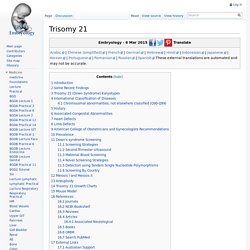

Amoeba Sisters Handouts - The Amoeba Sisters. Genetic Disorders. Genetic Disorders. File:Karyotype of a Klinefelter's syndrome patient.jpg - Embryology. Turner syndrome. Occurring in 1 in 2000[3] – 1 in 5000 phenotypic females,[4] the syndrome manifests itself in a number of ways.

There are characteristic physical abnormalities which affect many but not all people with Turner syndrome, such as short stature, swelling, broad chest, low hairline, low-set ears, and webbed necks.[5] Girls with Turner syndrome typically experience gonadal dysfunction (non-working ovaries), which results in amenorrhea (absence of menstrual cycle) and sterility. Concurrent health concerns may also be present, including congenital heart disease, hypothyroidism (reduced hormone secretion by the thyroid), diabetes, vision problems, hearing concerns, and many autoimmune diseases.[6] Finally, a specific pattern of cognitive deficits is often observed, with particular difficulties in visuospatial, mathematical, and memory areas.[7] §Signs and symptoms[edit] Lymphedema, puffy legs of a newborn with Turner syndrome The following is a list of common symptoms of Turner syndrome.
Trisomy 21 - Embryology. Introduction International classification of disease - Q90 Down's syndrome Down syndrome or trisomy 21 is caused by nondisjunction of chromosome 21 in a parent who is chromosomally normal and is one of the most common chromosomal aneuploidy abnormalities in liveborn children.

The frequency of trisomy 21 in the population is approximately 1 in 650 to 1,000 live births, in Australia between 1991-97 there were 2,358 Trisomy 21 (Down) infants. Down Syndrome is the historic name used for this condition identified by Down, J.L.H. in a 1866 paper[1] where he described the "phenotypic features that includes mental retardation and characteristic facies". Aneuploidy is the term used to describe any abnormal number of chromosomes either an increase or decrease in total number. Recent attention has focussed on screening for Down's syndrome (mainly in terms of cost and efficiency) during fetal life with over 350 articles in the medical literature in just the past five years.
Some Recent Findings History. Make A Karyotype. Chuckabees.pdf. List Index. What’s Your Biodiversity IQ? What’s Your Biodiversity IQ?

(Adapted from "Windows on the Wild") Procedures: Pass out quizzes and go over vocabulary. Divide the class into groups of three or four students, and give each group a copy of the quiz. Go over any words or terms that may be unfamiliar to the students. You can turn this activity into a quiz show game with you as the host. Wrapping it up Portfolio Either at the beginning or end of a unit, the quiz can serve as documentation of the students’ general knowledge of biodiversity.
Writing Idea Write each letter of the alphabet on a separate slip of paper. Extensions: Create a bulletin board or other display featuring the class definition of biodiversity, and magazine photos and student artwork that illustrate biodiversity. Resources: 1996 World Almanac (World Almanac Books, 1996). The Diversity of Life by Edward O. Encyclopedia of Insects by Christopher O’Toole (Andromeda Oxford Limited, 1995).
WOW! Cardiology Virtual Lab. Www.cde.ca.gov/ta/tg/sr/documents/cstrtqscience10.pdf. Www.cde.ca.gov/ta/tg/sr/documents/cstrtqbiology.pdf.
Sexual vs. Asexual. Cel Division. Genetics. Evolution. Life Science Lesson Plans.